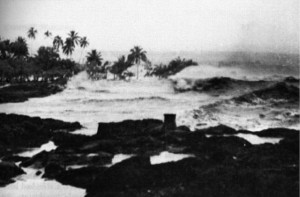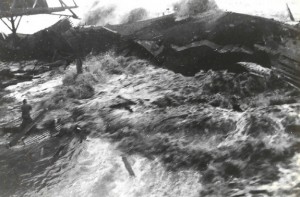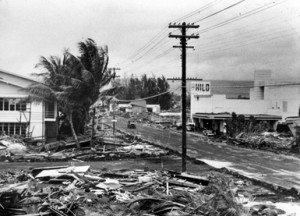Monthly Archives: April 2016
 Most of us think of April 1st as April Fools Day…a day recognized all over the world as a day set aside to pull pranks, hoaxes, and practical jokes on your friends neighbors and co-workers. I can remember many pranks pulled by my sisters, my parents, and me over the years. But, not everything that happens on April 1st can be considered a funny joke…as was the case on April 1, 1946, when a 7.4 magnitude earthquake was recorded in the North Pacific Ocean off of Unimak Island. The island is a part of the Aleutian chain in Alaska. When the earthquake struck, in the middle of the night, 13,000 feet beneath the surface of the ocean, a devastating tidal wave immediately hit the nearest land…Unimak Island. The wave estimated at 100 feet high, crashed into a lighthouse located 30 feet above sea level, where a five people lived. The lighthouse was smashed and the people living inside were killed instantly. They had no warning of impending disaster and death.
Most of us think of April 1st as April Fools Day…a day recognized all over the world as a day set aside to pull pranks, hoaxes, and practical jokes on your friends neighbors and co-workers. I can remember many pranks pulled by my sisters, my parents, and me over the years. But, not everything that happens on April 1st can be considered a funny joke…as was the case on April 1, 1946, when a 7.4 magnitude earthquake was recorded in the North Pacific Ocean off of Unimak Island. The island is a part of the Aleutian chain in Alaska. When the earthquake struck, in the middle of the night, 13,000 feet beneath the surface of the ocean, a devastating tidal wave immediately hit the nearest land…Unimak Island. The wave estimated at 100 feet high, crashed into a lighthouse located 30 feet above sea level, where a five people lived. The lighthouse was smashed and the people living inside were killed instantly. They had no warning of impending disaster and death.
The Wave then headed toward Hawaii, at 500 miles an hour. Hawaii was 2,400 miles south of the epicenter.  Captain Wickland of the United States Navy spotted the coming wave at about 7am…four and a half hours after the quake. Wickland’s position on the bridge was 46 feet above sea level, and he said he was eye level with a “monster wave” that was two miles long. I can only imagine how he must have felt looking at that wave. The word helpless is the first word to come to my mind. As the wave came into Hilo Bay, the water first receded, leaving ships on the sea floor beside fish flopping in the sand. Then, the tsunami struck full force. The wave was 32 feet high, and it completely destroyed about a third of the city. The Wailuku River bridge was picked up and relocated 300 feet from it’s original position. In Hilo, 96 people lost their lives. Other parts of Hawaii were hit by waves up to 60 feet. In Laupahoehoe, a schoolhouse was crush, killing the teacher and 25 students. The tsunami was seen as far away as Chili, where unusually high waves crashed ashore 18 hours after the earthquake hit. There were no casualties were reported there.
Captain Wickland of the United States Navy spotted the coming wave at about 7am…four and a half hours after the quake. Wickland’s position on the bridge was 46 feet above sea level, and he said he was eye level with a “monster wave” that was two miles long. I can only imagine how he must have felt looking at that wave. The word helpless is the first word to come to my mind. As the wave came into Hilo Bay, the water first receded, leaving ships on the sea floor beside fish flopping in the sand. Then, the tsunami struck full force. The wave was 32 feet high, and it completely destroyed about a third of the city. The Wailuku River bridge was picked up and relocated 300 feet from it’s original position. In Hilo, 96 people lost their lives. Other parts of Hawaii were hit by waves up to 60 feet. In Laupahoehoe, a schoolhouse was crush, killing the teacher and 25 students. The tsunami was seen as far away as Chili, where unusually high waves crashed ashore 18 hours after the earthquake hit. There were no casualties were reported there.
The tsunami brought to light a need for some kind of a warning system. The warning system, called the Seismic SeaWave Warning System was established two years later. It is now known as the Pacific Tsunami  Warning System, and it uses undersea buoys throughout the ocean, along with seismic activity detectors to predict killer waves. The system is still in use, and has warned many people in time to get to safety. Nevertheless, on its first use…November 4, 1952, the people evacuated successfully, but the wave never materialized. I suppose that could have been listed as a successful failure, but in that case, it wasn’t about whether or not the wave came, but rather, if it did, that the people were safely away. A system like this one can’t save everyone. I’m sure that some waves just get to land too quickly, but every life saved matters. The April Fools Day tsunami was on April 1st, but no one would call it a joke… and that’s for sure.
Warning System, and it uses undersea buoys throughout the ocean, along with seismic activity detectors to predict killer waves. The system is still in use, and has warned many people in time to get to safety. Nevertheless, on its first use…November 4, 1952, the people evacuated successfully, but the wave never materialized. I suppose that could have been listed as a successful failure, but in that case, it wasn’t about whether or not the wave came, but rather, if it did, that the people were safely away. A system like this one can’t save everyone. I’m sure that some waves just get to land too quickly, but every life saved matters. The April Fools Day tsunami was on April 1st, but no one would call it a joke… and that’s for sure.

